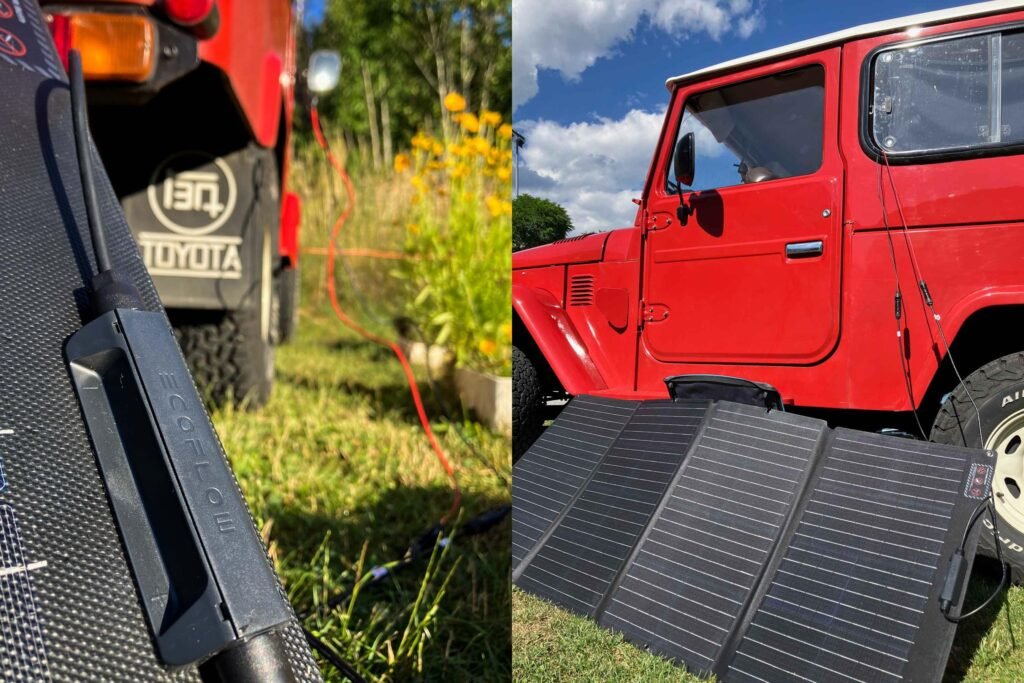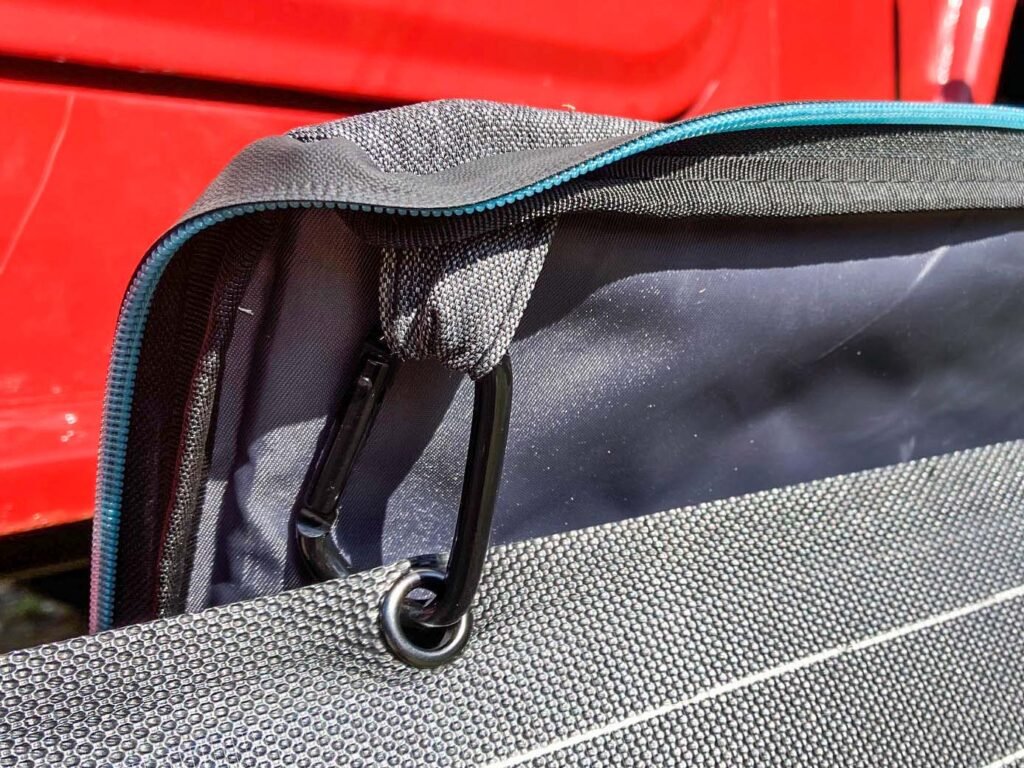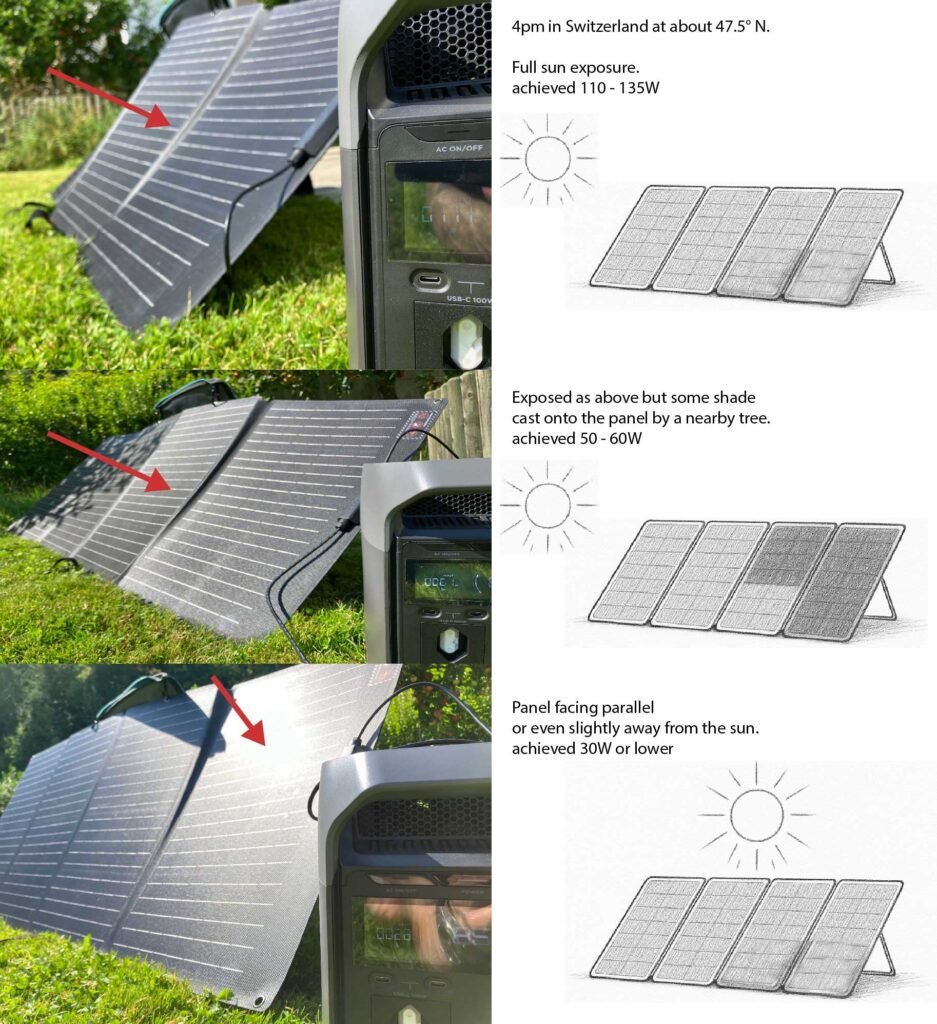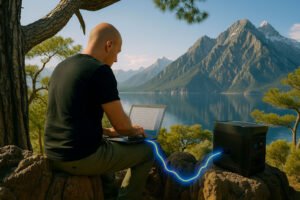EcoFlow 160W Solar Panel Review Real‑World Output – If you’ve read my EcoFlow Delta 3 review you already know I’m a fan of portable power solutions that keep you working and creating far from the nearest wall socket. But a power station is only as good as the energy you can feed into it. That’s where the EcoFlow 160W Solar Panel comes in: a foldable, weatherproof panel built to give you true independence from the grid and keep your creativity flowing, even in the middle of nowhere.
I took it into the field, tested it in changing weather, and compared it with competing panels to see if it delivers on EcoFlow’s promises.
Already looking for a reliable solar panel in the range of 160W?
Find the EcoFlow 160W Solar Panel here! (No affiliate link — just a helpful source.)
Still not quite sure if this portable solar panel is for you? Keep reading my review!
Table of Contents
1. Introduction – Why the EcoFlow 160W is Worth a Look
For digital nomads, vanlifers, and anyone working remotely, reliable off-grid power is freedom. The EcoFlow 160W Solar Panel is marketed as a lightweight, high-efficiency option for charging your EcoFlow power station or other compatible devices in the wild. At up to 23% efficiency and with an IP68 waterproof rating, it promises both performance and durability. But marketing specs don’t always tell the whole story. So I wanted to see how it performs in real-world conditions.
2. Unboxing & First Impressions
EcoFlow packs the panel in a sturdy cardboard box, well-protected for shipping. Inside you’ll find:
– The 160W foldable panel itself
– A 2.5 m solar cable with MC4 connectors
– The carry case (which doubles as a stand) including some carabiners
– Basic documentation
Setup is straightforward. Unzip the case, unfold the four connected panel sections, attach the straps and carabiners to your preferred angle, and plug it in. The 2.5 m cable is long enough to reach my EcoFlow Delta 3 inside my Toyota truck even on the opposite side of the vehicle No tools, no fuss. I had it charging within five minutes.

3. Design & Build Quality
The panel feels solid without being bulky. The carry case is made from durable fabric with a rigid panel on one side for extra protection. The zipper feels sturdy and is designed to be both water-resistant and dust-proof. It’s a one-piece foldable panel with four sections. The monocrystalline cells are protected under a layer of tough, flexible polymer that resists scratches and scuffs. When handling the panel, I noticed a a subtle ‘snap’ or ‘crack’ as I picked it up even when handling it carefully. This is something other users have also reported in online discussions but shouldn’t be a big issue.
– Unfolded dimensions: 157 × 68 × 2.4 cm
– Folded dimensions: 42 × 68 × 2.4 cm
– Weight: 7 kg (net)
The included carry case is clever: it’s padded for protection, seems reasonably water-resistant, and converts into a functional stand when hooked up with the carabiners (four of which are included). The whole setup has an IP68 waterproof rating, meaning it can handle rain and splashes.
The panel features reinforced eyelets for hanging or securing it in place. They feel solid, but are positioned close to the panel’s edge. Over years of use, especially if the full weight is supported by just one or two points, wear could become an issue. For hanging, it’s best to use as many eyelets as possible to spread the load and minimise stress on the fabric.

4. Tech Specs & Features
– Max output: 160W (under ideal test conditions)
– Efficiency: up to 23%
– Type: Monocrystalline silicon cells
– Output connectors: MC4 (adapter required for some devices)
– Cable length: 2.5 m
– Waterproofing: IP68
One detail I like: the panel is a single foldable unit, not separate pieces connected by hinges or cables, which means less setup time and fewer failure points.
5. Real-World Output of the EcoFlow 160W Solar Panel
“Numbers on a spec sheet are like prophecies — they sound grand, but only the sunlight will tell the true tale.” (Balian – First of the Generai Heroes)
EcoFlow’s 160W rating is under lab conditions – perfect sunlight at the ideal angle. In the field, numbers vary.
During a two week holiday trip camping with our Toyota as well as testing it out in my garden at home:
- Full Sunlight -> 110-135W my max output I managed to achieve
- with some clouds moving about -> 70-110W
- partial shadow cover: can drop the power by half.
- overcast (or no direct sunlight) -> 30W and can drop significantly…

One user review I found mirrors my results: “Charges my River 2 Max at 134 watts in full sun, and still gives me 90 watts with light cloud cover.” That’s impressive for a panel this size.
If you’re pairing it with a Delta 3, expect to add roughly 1.2–1.5 kWh per full day of strong sunlight, enough to keep a laptop, camera, and portable fridge running indefinitely.
6. Comparison – How It Stacks Up
In my EcoFlow 160W Solar Panel Review Real‑World Output, I compared the EcoFlow 160W with two common alternatives in the following table.
| Model | Max Output | Weight | Waterproof | Price | Quick Take |
|---|---|---|---|---|---|
| EcoFlow 160W | 160W | 7 kg | IP68 | Mid-range | Best build quality & clever case-integrated stand design |
| Jackery SolarSaga 200 | 200W | 6.2 kg | IP68 | Higher | Higher wattage in a lighter, well-sealed package, makes a great travel option. |
| Bluetti MP200 | 200W | 8.7 kg | IP67 | Similar | Robust build, heavier than competitors, and slightly less waterproof than EcoFlow or Jackery. |
As I do not personally own the competitor products, the review here remains on a technical level. Nevertheless, for me the EcoFlow’s waterproofing and portability make it a great choice for wetter climates or coastal travel. But simply spoken, I wanted to avoid any hassle a got the Ecoflow panel that was sure to be compatible with my EcoFlow Delta 3.
“A traveller chooses his tools like a knight chooses his sword — not for the shine, but for how it serves in the rain, the dust, and the long road ahead.”
(Balian – First of the Generai Heroes)
7. Pros & Cons
Pros:
– Excellent waterproofing (IP68)
– Solid real-world output in good conditions
– Clever carry case/kickstand design
– Lightweight for the wattage
– Easy, tool-free setup
Cons:
– No built-in USB output (adapter needed for direct device charging)
– Output drops sharply in full overcast
– Price per watt slightly higher than some competitors
8. Value for Money
At its current price, the EcoFlow 160W isn’t the cheapest per watt, but it offers superior build quality, portability, and weather resistance. If you value reliability and need a panel you can set up in minutes without worrying about the weather, it’s worth paying a small premium.
9. Final Verdict of the EcoFlow 160W Solar Panel Review Real‑World Output
The EcoFlow 160W Solar Panel delivers on its promise of dependable off-grid power in a portable, durable package. In real-world use, it consistently outputs around 120–130W in strong sunlight and keeps a usable trickle going even under clouds. For remote workers, travellers, and content creators, it’s a great match for EcoFlow’s own power stations – especially the Delta 3.
If you want the freedom to roam and write anywhere without hunting for a plug, this panel is an excellent companion. And by the way – if you’re looking for an easy and stable internet set up as well, see my “Teleboy Internet Test und Erfahrungen” here.
(No affiliate link — just a helpful source.)
10. FAQ
Can I use the EcoFlow 160W with non-EcoFlow power stations?
Yes – as long as your station accepts MC4 input or you use the right adapter.
How long does it take to charge a Delta 3?
In ideal conditions, expect 8–10 hours for a full charge from 0% using a single panel.
Does it work in winter?
Yes – cooler temperatures can actually improve efficiency, but short daylight hours limit total energy collected.
Can it charge directly to USB devices?
Not without an adapter – it outputs via MC4 connectors.
Is it really waterproof?
It has an IP68 rating, meaning it’s protected against dust and can withstand submersion in shallow water for short periods. So a splash of rain should be fine.



